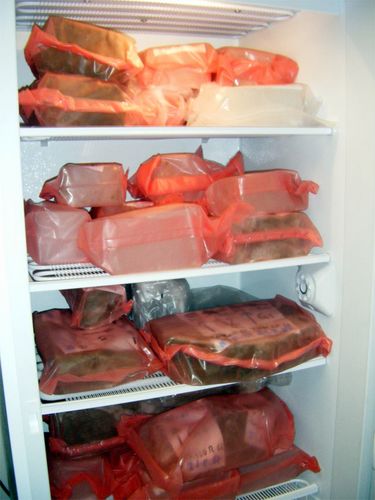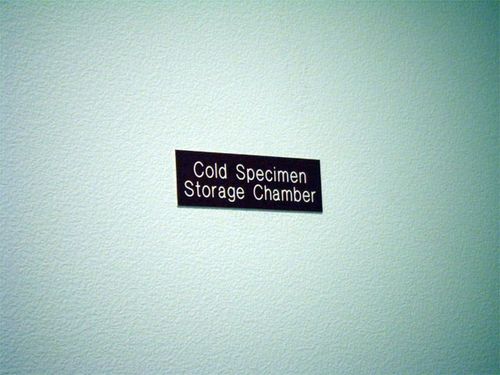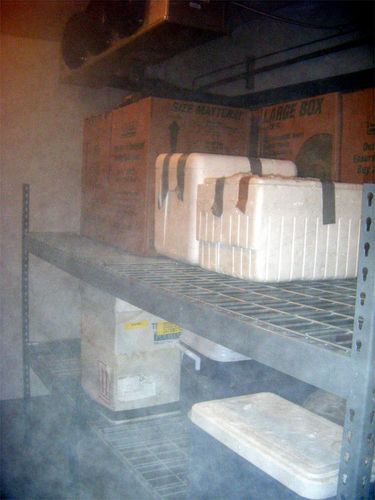Fellow polar treker Sarah Diers (Dissolved Organic Matter in Antarctica) and I had the awesome opportunity to meet our researchers and see their laboratories at Montana State University in Bozeman, Montana. My first impression was that Bozeman is amazing. It is a beautiful town surrounded by mountains. I could definitely live here. My trip was more than just sightseeing so I was so excited when I got to meet part of my research team. My team is made up of a researcher, a PhD student, and an undergraduate student from Montana State University and a researcher, a PhD student, and an undergraduate student from Louisiana State University. The seven of us will soon become one big dysfunctional family in Antarctica this October.
 Backrow (left to right) Tim, Scott, and Shawn will all be in the field with me this year. Brent (front right) will be there as well.
Backrow (left to right) Tim, Scott, and Shawn will all be in the field with me this year. Brent (front right) will be there as well.
I had three reasons for why I wanted to come and visit Montana State. #1: I wanted to learn about my expedition because I really had no clue about what was going on, #2: I wanted to see their lab and see what happens to the ice after we collect it in Antarctica, and #3: I wanted to meet at least half of my team in person before heading down to the ice. The first person that I met was Tim Brox. He showed me around the lab and explained the research projects. I was immediately struck by how smart he is and how many experiences he has had. He is only an undergraduate student but he has already been to Antarctica several times. He went for the first time when he was right out of high school and has found ways to get back there since. He is a physics student and is doing his own research on ice veins using thin slices of ice and advanced microscopes. He uses fluorescent dyes to see the ice veins when he looks at them under the microscope and it is really quite beautiful.
 Tim is holding a sample of ice taken from Antarctica during the 2007 field season.
Tim is holding a sample of ice taken from Antarctica during the 2007 field season.
The ice that we collect is shipped to universities around the world to be analyzed. Some of the universities that will look at our ice include the Université Libre de Bruxelles in Belgium, Louisiana State University, and Penn State University. At Montana State there are freezers everywhere full of ice sampled in the previous field season.
 One of the many freezers full of ice samples taken during the 2007 field season in Antarctica.
One of the many freezers full of ice samples taken during the 2007 field season in Antarctica.
In order to analyze the ice it needs to be kept cool at all times to keep its physical properties. Researchers bundle up in big coats and analyze the ice while in gigantic refrigerators called cold rooms.
 Sometimes scientists have to run experiments inside the cold room…better bundle up.
Sometimes scientists have to run experiments inside the cold room…better bundle up.
Montana State has a new facility with several different cold rooms kept at different temperatures. Researchers can set the cold rooms to specific temperatures for their experiments. One of the experiments that our team is doing looks at the respiration rate and cell death of microorganisms at specific temperatures. It is important to keep the temperature constant in these experiments or the results will not be accurate.
 Some of the ice that we collect is kept in cold rooms like the one behind this door.
Some of the ice that we collect is kept in cold rooms like the one behind this door.
 Inside the cold room at Montana State University.
Inside the cold room at Montana State University.
When we collect the ice from the Antarctica it is in big blocks (see the refrigerator picture above). However to look at it, we need it in thin slices. This is harder to do than you might think. The ice we collect is from the bottom of the glacier and contains a lot of small rocks and sediment. Some pieces have so much sediment in them that they are more like cement than ice. To cut it accurately you need a really good saw and Montana State happens to have one. It uses a thin wire studded with diamonds to slice the ice accurately. To see it we had to go inside the cold room....brrrr.
 Inside the cold room is the saw used to precisely cut the ice that we collect in the field.
Inside the cold room is the saw used to precisely cut the ice that we collect in the field.
 The cold room that houses the saw and some of the ice samples is kept at -10 degrees F. If you want to use the saw, you had better bundle up.
The cold room that houses the saw and some of the ice samples is kept at -10 degrees F. If you want to use the saw, you had better bundle up.
The more I learn about my expedition, the more excited I get...

